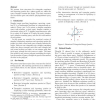SODA
2008
ACM
14 years 8 months ago
2008
ACM
We describe an asymptotically optimal data-structure for dynamic point location for horizontal segments. For n line-segments, queries take O(log n) time, updates take O(log n) amo...
NIPS
2007
14 years 8 months ago
2007
Can we leverage learning techniques to build a fast nearest-neighbor (ANN) retrieval data structure? We present a general learning framework for the NN problem in which sample que...
CCCG
2008
14 years 8 months ago
2008
We present data structures for triangular emptiness and reporting queries for a planar point set, where the query triangle contains the origin. The data structures use near-linear...
FAW
2008
Springer
14 years 8 months ago
2008
Springer
We propose path-merging as a refinement of techniques used to make linked data structures partially persistent. Path-merging supports bursts of operations between any two adjacent ...
EUROPAR
2008
Springer
14 years 8 months ago
2008
Springer
We present a distributed index data structure and algorithms devised to support parallel query processing of multimedia content in search engines. We present a comparative study wi...
ESOP
2008
Springer
14 years 8 months ago
2008
Springer
A data structure is said to be persistent when any update operation returns a new structure without altering the old version. This paper introduces a new notion of persistence, cal...
ESA
2008
Springer
14 years 8 months ago
2008
Springer
Abstract. We present data structures for maintaining the relative convex hull of a set of points (sites) in the presence of pairwise non-crossing line segments (barriers) that subd...
COMPGEOM
2008
ACM
14 years 8 months ago
2008
ACM
We study the problem of two-dimensional Delaunay triangulation in the self-improving algorithms model [1]. We assume that the n points of the input each come from an independent, ...
DEXAW
2007
IEEE
14 years 8 months ago
2007
IEEE
Due to the lack of efficient native XML database management systems, XML data manipulation and query evaluation may be resource-consuming, and represent a bottleneck for several ...
DEBS
2007
ACM
14 years 8 months ago
2007
ACM
Content delivery is becoming increasingly popular on the Internet. There are many ways to match content to subscribers. In this paper, we focus on subsumption-based matching. We p...





